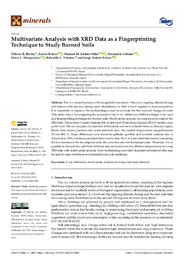Título :
Multivariate Analysis with XRD Data as a Fingerprinting Technique to Study Burned Soils |
Autor :
Rocha, Débora R
Barber, Xavier
Jordan Vidal, Manuel M.
Urbano, Alexandre
Melquiades, Fábio L.
Thomaz, Edivaldo L.
Mataix-Solera, Jorge  |
Editor :
MDPI |
Departamento:
Departamentos de la UMH::Agroquímica y Medio Ambiente |
Fecha de publicación:
2022-11-02 |
URI :
https://hdl.handle.net/11000/37766 |
Resumen :
Fire is a natural process with recognized recurrence. However, ongoing climate change
and human activities are causing some disturbances in their natural regimes in most ecosystems.
It is important to improve the methodologies used to evaluate the fire-induced changes in soils.
This study aims at investigating the potential of the X-ray diffraction (XRD) technique to be used
as a fingerprinting technique for burned soils. Multivariate analysis was employed to analyze the
XRD data. Hierarchical Cluster Analysis (HCA) and local Partial Least Squares (PLS-2) models were
performed. The soil samples are classified as Ferralsols and were collected from an Amazon region,
Brazil, from forests, pastures and a slash-and-burn area. The studied temperatures ranged between
25 and 800 ◦C. Major differences were found for gibbsite, goethite and kaolinite contents due to
dehydration. PLS-2 analysis presented better results than HCA as it provided information concerning
the two features of the investigated soils, the collection site and the temperature. Therefore, it was
possible to characterize soils from different sites and soils heated at different temperatures by using
XRD data with multivariate analysis. Such methodology provided important information that may
be used in areas with these environmental and soil conditions.
|
Palabras clave/Materias:
X-ray diffraction
multivariate analysis
burning simulation
ferralsol |
Área de conocimiento :
CDU: Ciencias puras y naturales |
Tipo de documento :
info:eu-repo/semantics/article |
Derechos de acceso:
info:eu-repo/semantics/openAccess
Attribution-NonCommercial-NoDerivatives 4.0 Internacional |
DOI :
https://doi.org/10.3390/min12111402 |
Publicado en:
Minerals 2022, 12(11), 1402 |
Aparece en las colecciones:
Artículos Agroquímica y Medio Ambiente
|
 La licencia se describe como: Atribución-NonComercial-NoDerivada 4.0 Internacional.
La licencia se describe como: Atribución-NonComercial-NoDerivada 4.0 Internacional.
.png)
